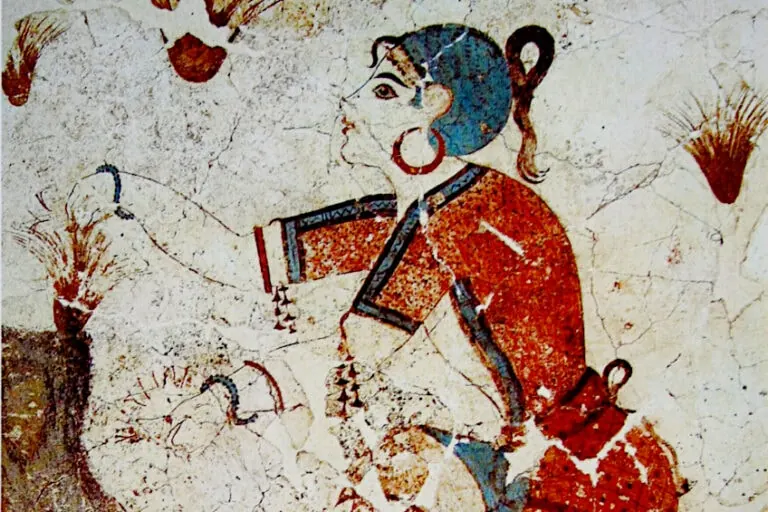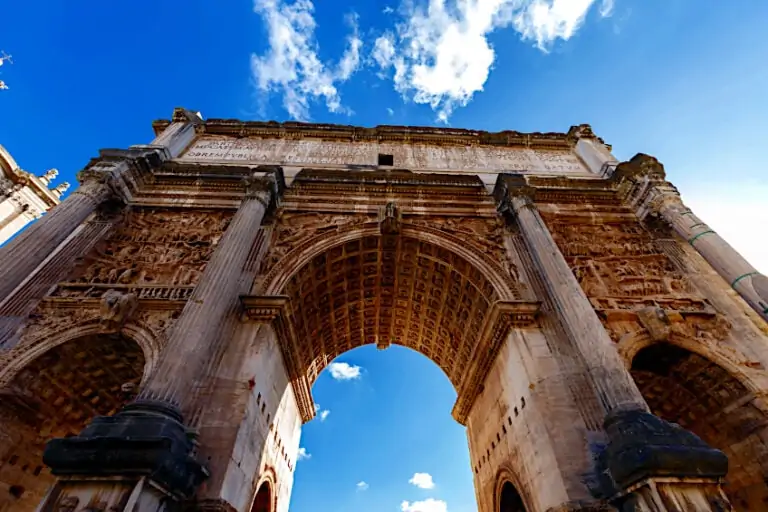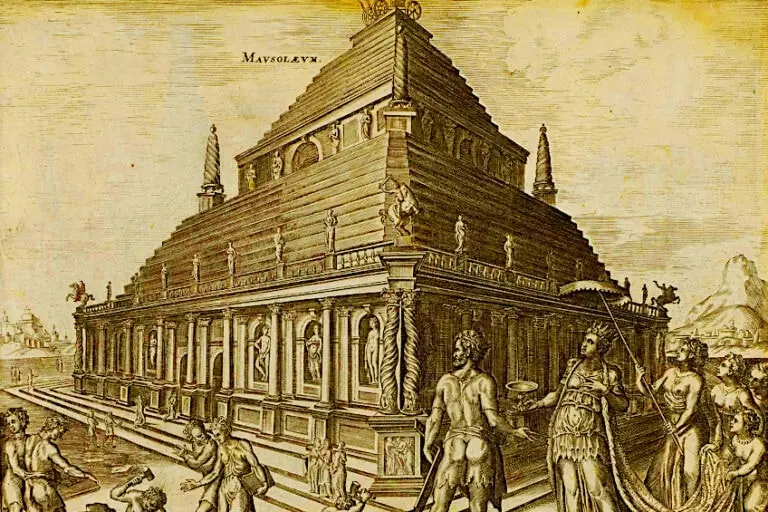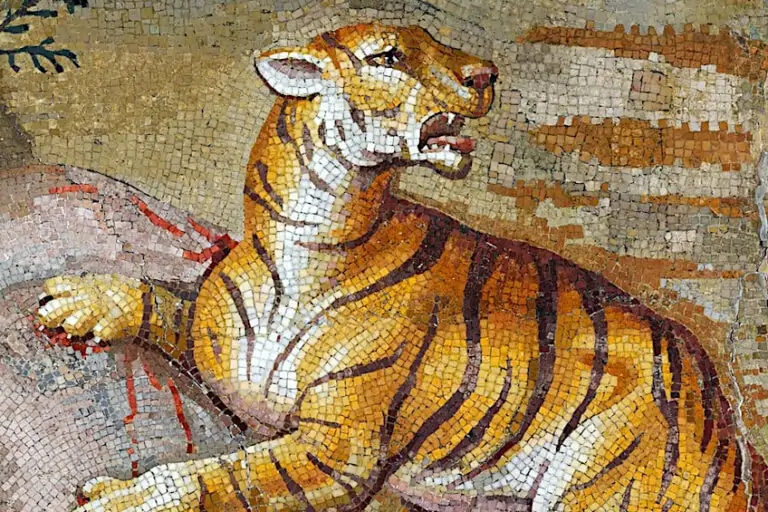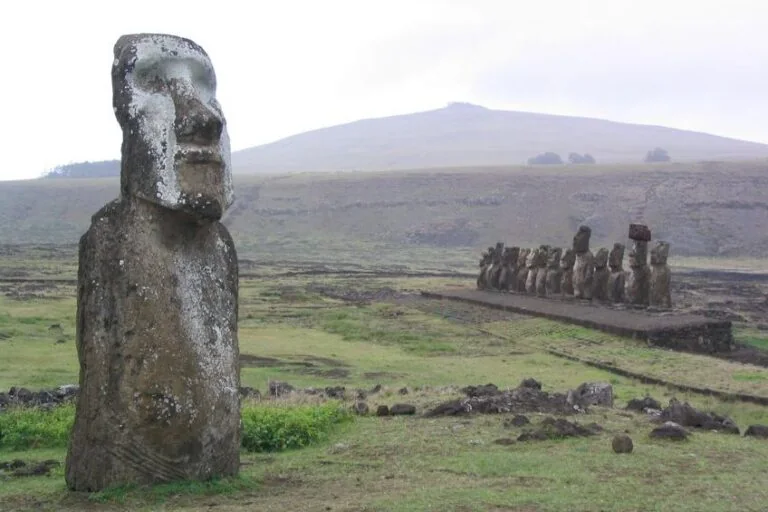Kailasa Temple at Ellora – The Temple Carved into Mountain Rock
There are plenty of landmarks around the world that draw the attention of absolutely everyone. Those that do often have some lore or backstory that gives them a little bit of extra appeal in the eye of the viewer, and none have quite as interesting of a backstory as the Kailasa temple at Ellora. This stone temple is easily one of the most impressive monuments ever constructed in both modern and ancient times, so we thought it would be a good idea to explore this structure. We will be having a look at exactly what the Kailasa temple at Ellora is, where it’s located, what it’s made out of, and how it was made. This being said, let’s have a look at this temple and the story behind its inception.
Contents
The Kailasa Temple at Ellora
| Architect | Commissioned by Rashtrakuta King Krishna |
| Dimensions (m) | 33.22 x 44.98 |
| Date of Construction | 756 – 773 CE |
| Location | Ellora, Maharashtra 431102, India |
| Type of Architecture | Dravidian architecture |
| Design Influences | Southern Indian temple design style |
| Purpose | Devotion to Lord Shiva |
There are many temples around the world designed for dedication to various deities. However, none are quite as impressive as the famous temple carved into a mountain. That’s right, the Kailasa temple has been carved out of a single block of solid stone that was once part of the local mountainside. If the gravity of this is lost on you, the famous Statue of David took three years to create.
This entire temple was constructed within a week. Still not impressed? Well, the entire temple was carved from a single piece of volcanic rock, which led to the removal of around 200,000 tons of the stuff being chipped away and removed from the area so that sculpting and shaping could begin. The sheer scale of this temple and the speed of its construction is staggering, even by today’s standards.
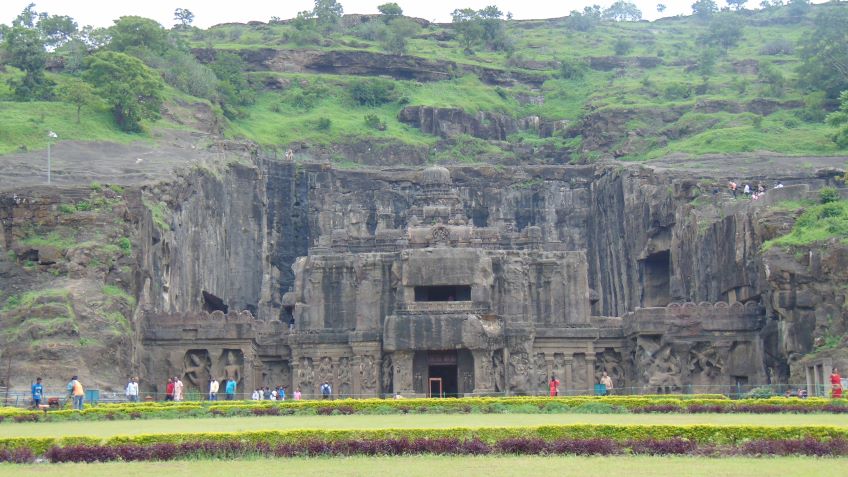 Kailasha Temple, Ellora (756 – 773 CE); Prasant1995, CC BY-SA 4.0, via Wikimedia Commons
Kailasha Temple, Ellora (756 – 773 CE); Prasant1995, CC BY-SA 4.0, via Wikimedia Commons
Strangely enough, even though this temple is objectively impressive, it isn’t the only one of its kind in the region. According to recent statistics, there are more than 34 other cave temples located in and around the mountainside, all of which have been handcrafted and perfectly set. However, none of these temples are quite as unique as the temple carved into a mountainside.
The Ellora caves are still quite an attraction though. They showcase the ingenuity and cooperation of our ancestors, and just what’s possible when people work towards a common goal. Not all of the temples were created equally though, the Kailasa temple is the only one that has been declared a world heritage site by UNESCO.
This comes as no surprise considering that the temple is the largest monolithic structure on the face of the planet. This means that the entire structure has been carved from a single piece of stone, including the archways, statues, pictographs on the interior, stairs, and the additional structures located inside the cave system.
Was the Temple Really Built in a Week?
Anyone who’s ever seen a house being built probably has some skepticism toward the fact that this temple was built in a week, and if so, you’d be justified in feeling that way. While the legend of the temple’s construction states that it was built in a week, in reality, it took around 18 years for the full structure to be carved and excavated. The planning alone would have taken months, as, unlike conventional construction techniques, there would have been no way to add material to the design should the structure be unsound. The level of accuracy and planning needed to execute a project like this in a time before ground-penetrating radar and electronic tools would have been ludicrous.
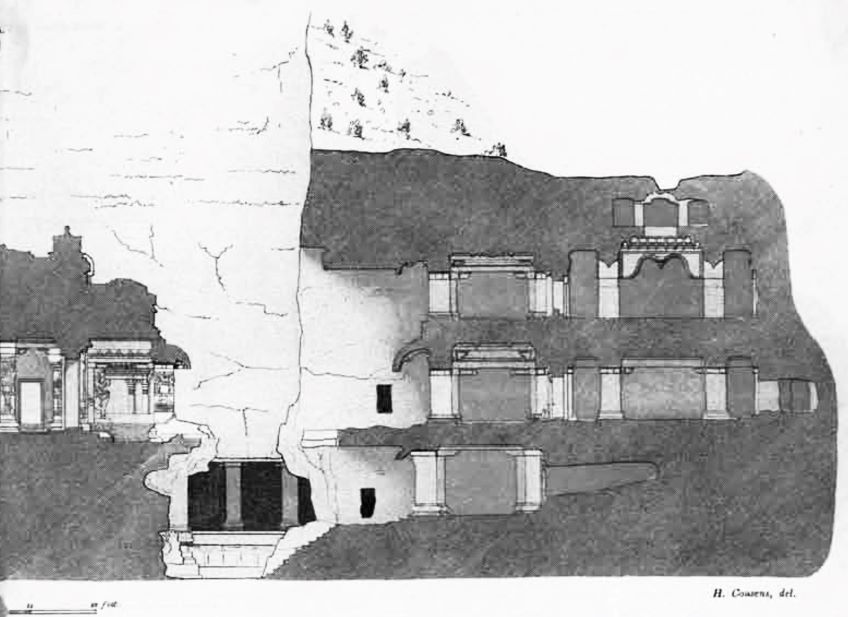 A transverse section of the Kailasha temple Cave 16 Ellora showing three levels (1883) by J Burgess; J Burgess (1883), Public domain, via Wikimedia Commons
A transverse section of the Kailasha temple Cave 16 Ellora showing three levels (1883) by J Burgess; J Burgess (1883), Public domain, via Wikimedia Commons
Even though this temple is already extremely impressive at first glance, it is even more impressive when compared to similar structures from around the world. Even compared to the Greek Parthenon, it covers more than double the surface area, and even other Indian landmarks like the Taj Mahal barely come close to the scale and complexity of this temple structure.
What Is Inside the Ellora Caves?
While the surface structures are decidedly impressive, there is, even more, to see when entering the Ellora caves underneath the primary temple. The cave system is vast and was painstakingly carved by hand. Guided tours of the cave system and the surrounding regions are common and quite sought after too. What exactly is inside these famous caves though? Well, there are loads of pictographic art forms and sculptures that can be viewed throughout the cave system.
Some of the most popular attractions are the elephant sculptures and the absolutely massive pillars near the entrance of the caves. These have been carved in the same overall style as the rest of the temple, but with notably more detail.
Other notable works of art that can be found in and around the structures are depictions of Nandi (the sacred bull of the God Shiva) and a pride of lions on the ceiling who are all standing in a circle around Mahamantapa. There are also load-bearing pillars that have been shaped into elephants, giving the impression that these great beasts are holding the structure up through their will alone.
As you make your way through the temple, you’ll soon find depictions of some of the greatest Hindu tales told to date. There are impressions detailing both the Mahabharata and the Ramayana, not to mention several variations of the Hindu God Vishnu in different poses and situations. Out of all of the storied depictions, there is one that tends to stand out to new visitors.
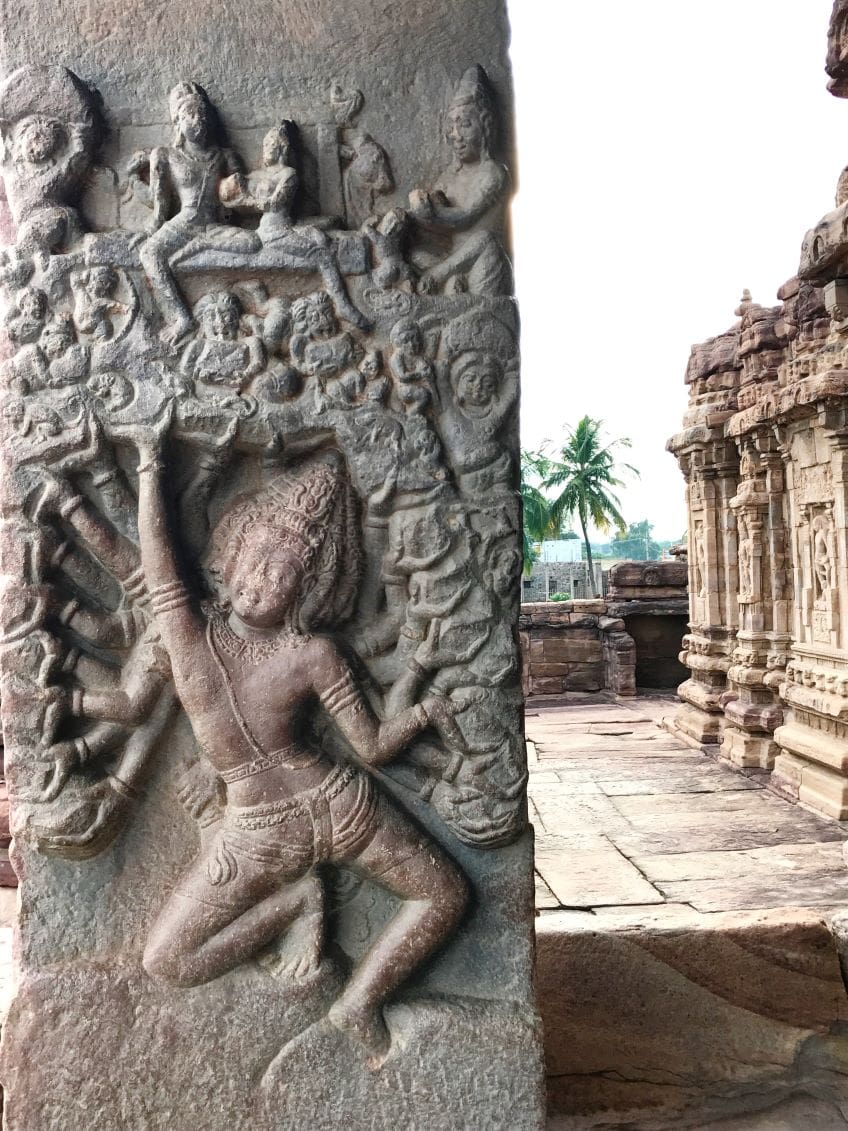 8th century Ravana lifting Kailasha parvat legend (756 – 773 CE); Ms Sarah Welch, CC BY-SA 4.0, via Wikimedia Commons
8th century Ravana lifting Kailasha parvat legend (756 – 773 CE); Ms Sarah Welch, CC BY-SA 4.0, via Wikimedia Commons
This is the depiction of Ravana, the demon king in Hindu mythology. In this relief, he is pictured underneath the temple as he attempts to lift the entire structure. This makes sense in the context of the mythology as Shiva is considered to be the protector of mankind, so it seems only fitting that Shiva’s adversaries would seek to destroy a structure dedicated to them.
The Legend of the Kailasa Temple
Like all great monuments, there’s usually a bit of backstory attached to its construction and it’s the reason it was built in the first place. The story behind the creation of the temple is one of illness, faith, and commitment to a cause. The legend goes that the King at the time had been overcome with a great illness and all by all indications he would not survive. As a result, his wife began to pray to the God Shiva for guidance and to make her husband healthy again. It appears that faith would not be enough though, as the queen sought to please Shiva by not only constructing a great monument in their honor but pledging to fast until the peak of the monument’s structure had been completed.
When the king and his wife realized that it would take years for the monument to be constructed it seemed that they would simply be exchanging one of their lives for the other. Thankfully, the architect behind the design of the temple had the genius idea of constructing the temple from the top down, finishing the peak of the temple in only a week.
This is where the misconception of the entire temple being completed in a week comes into play. The queen was therefore able to honor her arrangement with Shiva and save her husband’s life all in one go, and she only had to fast for a week! Thus, the temple was constructed starting at its peak, and the “foundation” was carved towards the end of the project.
If we look at the philosophy of ancient architecture like this, it is often said that humans build structures toward the heavens in an effort to be closer to their gods. In this instance, the temple was built downward, which as you may have noticed is in stark contrast to this philosophy. However, the commitment by both the king and his wife to the construction of this enormous temple is a clear testament to their faith.
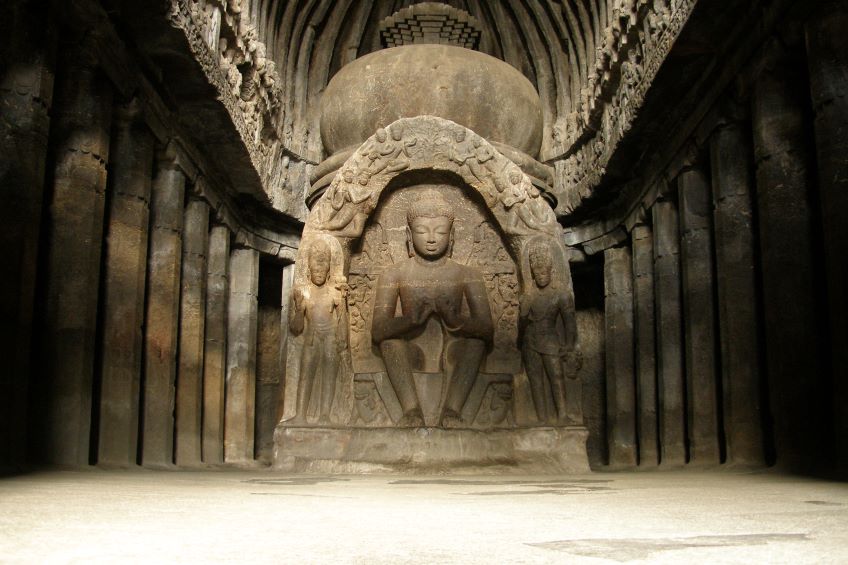 Ellora Caves, India (756-773 CE); © Vyacheslav Argenberg / http://www.vascoplanet.com/, CC BY 4.0, via Wikimedia Commons
Ellora Caves, India (756-773 CE); © Vyacheslav Argenberg / http://www.vascoplanet.com/, CC BY 4.0, via Wikimedia Commons
This being said, all of the aforementioned is mostly legend. Although the temple was definitely built from top to bottom, there are no historical documents backing up the tale. However, 200,000 tons of volcanic rock were moved from the area, and it seems that later rulers kept adding on to the temple, whether it be through interior carvings or exterior courtyards and statues.
There are other indications that there might be some truth to the legend of the temple’s construction.
In the main entryway, there are two carvings on the surface of either pillar. On the right-hand side, there is a depiction of the god Shiva, and on the left-hand side, there is a depiction of another renowned Hindu god Vishnu. These two stand both opposed to one another, and yet simultaneously guard the temple’s entrance.
The Temple Could Not Be Destroyed
There is yet another legend that states the temple came under attack by a later king who believed that he could destroy the temple by sending some of his disciples to take down the stone works with hand tools. As the legend goes, the king sent his disciples to the Kailasa and they immediately began chipping away at the monument with picks and axes.
To their surprise, despite their best efforts, they were unable to do any damage to the temple or the artwork inside of it. According to the legend around 1000 men were sent into the temple to destroy it in the year 1682, but despite the temple being carved using hand tools, the men were unable to do anything except damage the surface of a few statues.
It is said that eventually the king gave up and had his men return home. Whether the account is true or not remains to be seen, but from a mythological standpoint, it makes sense that the worship place of the lord Shiva would have supernatural protection against the deeds of non-believers.
Alternatively, the servants of the king could simply have been using inadequate tools. It is worth mentioning that the act of divine intervention is a fairly common occurrence in Hindu mythology, and the line between mortal men and deities is often blurred. This is often framed as a good thing, as the people in these stories and legends often have a close relationship with the deities they interact with, allowing them to earn god’s favor through service.
Representation of Mount Kalash
In the Hindu faith, the god Shiva resides on Mount Kalash, and this temple and all of the iconography inside are meant to represent this holy place. As one enters the temple, you will find two courtyards, one on your left and one on your right. At the center of each of these courtyards, you will find an absolutely massive stone elephant, which much like the temple itself has been cast of a single piece of stone. Near the elephants are 15-meter-tall pillars that emphasize the sheer scale of both the elephants and the structure at large. Shiva’s sacred bull is also depicted near the courtyards. Both the spaces that have been dedicated to Shiva’s sacred bull Nandi and Shiva herself are over seven meters tall and have been constructed over two stories.
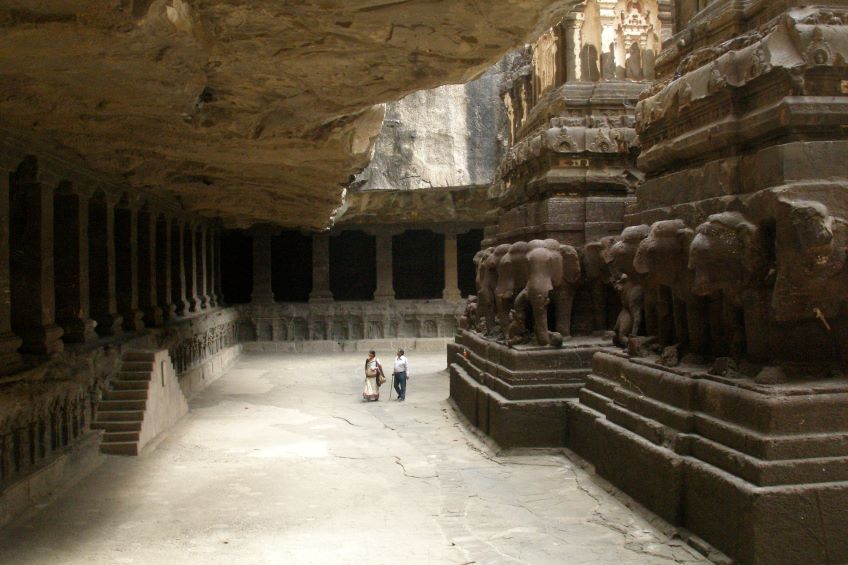 Ellora Caves, India (756-773 CE); © Vyacheslav Argenberg / http://www.vascoplanet.com/, CC BY 4.0, via Wikimedia Commons
Ellora Caves, India (756-773 CE); © Vyacheslav Argenberg / http://www.vascoplanet.com/, CC BY 4.0, via Wikimedia Commons
If anything, there was a lot of effort put into making the structure resemble Mount Kalash as much as possible. Upon its initial construction, the temple was coated with a layer of white plaster on the exterior to represent snow that would form on the top of Mount Kalash due to how high it is. This later faded over time, and we’re left with the exposed stone we see today.
Cultural Representations in Architecture
Various cultural and religious icons have been incorporated into the Kailasa temple. From the moment your eyes reach the entrance of the palace, you will be greeted by a low gopuram (a small tower common at the entrance of East Indian temples), something that is fairly common in Hindu places of worship throughout Southern India. Once you pass through this archway, you will find a u-shaped courtyard with dedications to two deities on either side.
Immediately on your left-hand side, you will find an area dedicated to Shiva, and on the right-hand side, you will find an area dedicated to Vishnu (as we mentioned previously). It appears that these reliefs were constructed first judging by the style of the artwork and the age of the exposed rock. Later on, dedications to various other deities and religious narratives would be added as the temple was extended.
The courtyard you enter into is a staggering 82 x46 meters, a size which would have been exceedingly difficult to achieve if the temple was constructed by traditional means.
The arcade that forms part of the courtyard isn’t small in stature either, it reaches up to three stories high and features a panel with a wide variety of deities displayed in various positions on the surface. When the temple was originally constructed, there were a series of flying bridges that connected all of the viewpoints of the temple, but due to decades of decay, they have fallen down. These would have given you an incredible view of some of the awesome statues, such as the one of Shiva dancing, one where she is being warned by Parvati, and some intricately carved depictions of both the river goddess and the demon Ravana.
Once you’ve been awed by the surrounding beauty of the courtyard, you’ll likely be drawn toward its center. In the middle of this enormous carved courtyard is the primary shrine of the temple, one that has been dedicated to the worship and honor of the lord Shiva. One can pray and leave offerings to the deity at this point in the temple, and it is not uncommon for people to come from far and wide to pay tribute here.
 Ellora Caves, India, Shikhar of Indra Sabha Temple (756-773 CE); © Vyacheslav Argenberg / http://www.vascoplanet.com/, CC BY 4.0, via Wikimedia Commons
Ellora Caves, India, Shikhar of Indra Sabha Temple (756-773 CE); © Vyacheslav Argenberg / http://www.vascoplanet.com/, CC BY 4.0, via Wikimedia Commons
The shrine is surrounded by a low-roofed Mandapa that is held up by exactly 16 pillars, all of which have been carved from the same rock as the rest of the temple structure. Inside the shrine, itself is the lingam, an object that is meant to represent the Shiva deity, and the primary focus of one’s prayers when engaging in worship. Attached to the Mandapa is a shikhara (temple head) of Dravidian styling that has also been cast out of the same stone as the temple surrounding it.
Once one enters the shrine you will find yourself in a space lined with windows, archways, plaster reliefs, and many other intricately detailed features that can be overwhelming if you’re trying to catch every little detail of the space.
As is tradition with any structure dedicated to Shiva, there must also be a depiction of Nandi. In this instance, Nandi can be found both at the entrance to the temple structure and closer to the primary shrine. There are many depictions of Nandi, Shiva, and mithunas (male reliefs) throughout the primary shrine and greater temple structure.
Why Is the Temple So Revered?
There are loads of temple structures around the world, some are even larger and more intricately built than the Kailasa, so what makes this one so special? Well, there are loads of things to take into account when it comes to the Kailasa temple that other large structures simply don’t have, making it an entirely unique piece of architectural history.
Firstly, the temple is an important place of worship for those seeking guidance and/or blessing from Shiva. Her presence can be seen and felt throughout the structure, not just inside that primary shrine, and as a result word of the amazing spiritual experience the temple offers has spread, adding to its popularity over the years.
Second is its architecture. Even though the primary influence of the architectural style is Southern Indian, the numerous successors of the king who commissioned its construction have added and integrated various design styles and carvings into the temple. It is the combination of these design choices merging together so seamlessly that make this temple unique.
Thirdly, is the manner in which it was constructed. It should go without saying that constructing an entire temple out of a single piece of volcanic rock is a herculean task, but doing so from the top down seems nearly impossible. Despite the immensity of this challenge, temple designers have shown that with enough planning, tools, and the right material, virtually anything is possible.
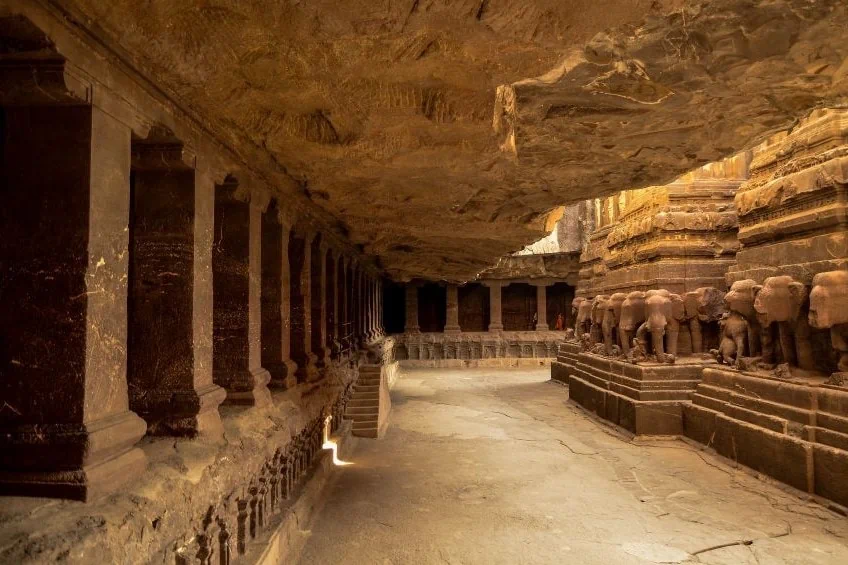 The Kailaśa temple, Cave 16 (756-773 CE); Akshay Prakash, CC BY-SA 4.0, via Wikimedia Commons
The Kailaśa temple, Cave 16 (756-773 CE); Akshay Prakash, CC BY-SA 4.0, via Wikimedia Commons
Fourth is the level of detail and the narrative iconography has been integrated into the very walls of the temple and shrine structures. Great Hindu epics and depictions of powerful deities line the walls, pillars, archway, and even the ceilings of this structure. This being said, whether it’s your first time visiting or your fourth walkthrough, there is always something new to see!
Lastly, it’s the size of the temple structure itself. While the Kailasa temple is an impressive feat of engineering and construction, the fact that it’s only one of dozens of temples like these in the cave system is astounding. The combination of all of these characteristics makes it easy to see why it has been deemed a UNESCO world heritage site and a must-see when visiting Southern India.
Now that you know what the Kailasa temple is, why the Kailasa temple was constructed, how the temple was built, what is inside of it, and a little bit about the deities and scenes depicted on its interior, it’s time for you to get out there and put your newfound knowledge to the test. If you intend on visiting the temple, be sure to check out the rest of the cave system too!
Frequently Asked Questions
Where Is the Kailasha Temple Situated?
The Kailasha temple is one of the most revered monuments in all of India. Where is the Kailasha temple situated though? The Kailasha temple can be found at the Ellora Caves.
What Is the Single Stone Temple in India?
There are many stories about the single-stone temple in India. The temple in question is called the Kailasa or Kailasha temple, and its popularity is due to the fact that the entire temple was cut from a single block of volcanic rock. The temple was made by cutting the rock from the bottom downwards.
How Old Is the Kailasa Temple?
The Kailasa temple is believed to have been constructed sometime between 756 and 773 CE, making the temple 1250 years old! This temple is believed to have taken around 18 years to construct, which is surprising considering that the entire structure has been cast from a single piece of volcanic rock.

I am deeply passionate about history and am constantly fascinated by the rich and complex stories of the past. As the editor-in-chief of learning-history.com, I have the opportunity to share this passion with a wide audience through the creation and distribution of engaging and informative content about historical events, persons, and cultures. Whether it’s through writing articles and blog posts or creating videos or podcasts, I strive to bring the past to life in a way that is both accurate and enjoyable. My expertise in history, combined with my strong writing and communication skills, allows me to effectively communicate complex historical concepts and make them accessible and interesting to a wide range of readers. I am truly grateful for the opportunity to share my love of history with others through my work on learning-history.com.

